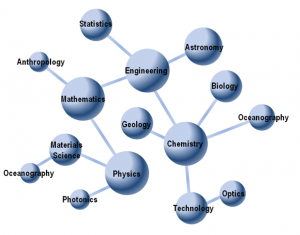Professor Larsen at the University of California at Davis started the ChemWiki in 2008 on a shoestring. “ChemWiki is not a textbook,” says Larsen, “it is a textbook environment capable of supporting multiple chemistry textbooks within a centralized system.”
- Recently, ChemWiki received a grant of $250,000 from the National Science Foundation to a consortium that includes Sonoma State University, Diablo Valley College, Contra Costa Community College, Hope College, and the University of Minnesota at Morris.
- The ChemWiki is designed in a non-linear way. Students can jump from topic to topic, so knowledge is constructed to suit an individual’s interests and needs.
- This non-linear approach makes it easier to see patterns and connections while building up a frame of understanding with each “jump.”
- The Hyperlibrary consists of seven interconnected “STEMWikis” developed by a team of faculty and students that represent Chemistry, Physics, Mathematics, Geology, Statistics, Engineering, Molecular and Cell Biology, and Evolution and Ecology.
- The primary goal of the Hyperlibrary development team is to construct multiple STEMWikis that will re-conceptualize the way STEM courses are taught.
- The STEMWikis offer students easy access to vetted course textbook materials and provide an integrated infrastructure for faculty to adapt and adopt existing materials to suit their specific needs.
- The STEMWikis follow a “bottom-up” modular development approach involving faculty and students with faculty contributing content and organization, while students contribute through supporting tasks like content integration and evaluation.
- The success of the ChemWiki can be directly attributed to the high level of student effort and participation.
- At present there are three levels of student involvement: as uploaders and integrators for existing content; as content developers by transcribing their own notes or building Modules and Wikitexts from scratch; and, as unique contributors.
- The ChemWiki had visitor traffic of 18 M visits with 26 M page views per year and an estimated 1634 hours of reading/writing occurring daily.
- According to Alexa.com, the ChemWiki is the most visited sub-domain of UC Davis with 9.2% of incoming campus traffic.
- While the majority of online traffic comes from the United States, the ChemWiki has become an invaluable resource to students around the globe, including the United Kingdom, Canada, India, Philippines, Australia, Malaysia, Pakistan and Singapore.

Dr. Larsen will be sharing his insights and lessons learned about the ChemWiki project at the 97th Canadian Chemistry Conference and Exhibition, taking place in Vancouver, B.C. from June 1 – 5, 2014.
Notable Quote:
ChemWiki is not a textbook; it is a textbook environment capable of supporting multiple chemistry textbooks within a centralized system. ~ Professor Larsen
